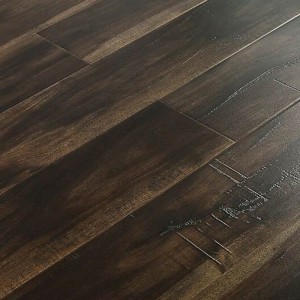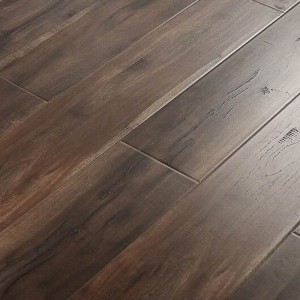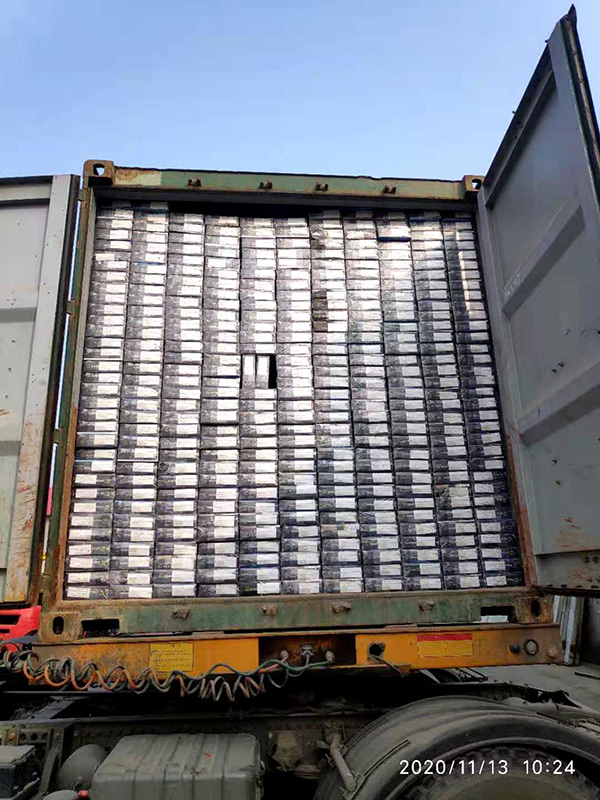
















Parameter
| Color | We have several hundreds of color for your choice. | ||
| Thickness | 7mm, 8mm, 10mm, 12mm are available. | ||
| Size | 1218*198,1218*168,1218*148,1218*128, 810*130,810*148,800*400,1200*400,600*100 | ||
| Surface treatment | More than 20 kinds of surface, such as Embossed, Crystal, EIR, Handscraped, Matt, Glossy, Piano etc. | ||
| Edge treatment | Square Edge ,Mold press U-groove , 3 strips U grovoe, V-Groove with painting, bevel painting, waxing, padding, press etc. are provided. | ||
| Special treatment | Press U-groove,Painted V-groove,Waxing, Logo painted on back ,Soundproof EVA/IXPE | ||
| Wear Resistance | AC1,AC2, AC3,AC4, AC5 standard EN13329 | ||
| Base materials | 770 kg /m³,800 kg /m³, 850 kg /m³ and 880 kgs /m³ | ||
| Click system | Unilin Double , Arc , Single , Drop ,Valinge | ||
| Installation Method | Floating | ||
| Formaldehyde Emission | E1<=1.5mg/L, or E0<=0.5mg/L | ||
What problems does EIR Laminate Flooring easily happen? How to solve it?
As the most common and conventional flooring material, EIR Laminate Flooring has been recognized by the market for its affordable price and practicality. At the same time, some problems after the installation of the laminate floor have also followed.
1. The seams are bulging
A. Foaming on the laminate floor surface: When mopping the floor, dripping water from the mop or shoe moisture will cause water to accumulate on the floor surface and enter from the joints with less sizing. In this case, the joints on the floor surface partially bulge;
B. Water ingress and bulging under the floor: The surface phenomenon is that the joints bulge in a more uniform shape, the places near the water source are heavier and stricter, and the distances become more and more flat. Such problems are: near the bathroom, kitchen, Heating pipes, air conditioning condensate drains, windows, etc. If the water has been immersed for a long time, the surface phenomenon is no longer obvious, you can open the floor to check whether there is a watermark;
C.Laminate Wood Floor short joints bulge: It is manifested as the bulge of each short side joint of the long strip floor, which is generally caused by excessive ground moisture. The higher the bulge, the greater the ground moisture.
2. Floor is Arched
The arching of the floor is due to the expansion of the floor when it is damp and under the action of temperature, the size increases and the floor is firmly assembled together and cannot stretch it. It can only swell upwards and arch. The reasons are as follows:
A. After the floor is soaked, the volume of the floor increases, causing arching;
B. When laying the floor, it is a dry season, and the locks are installed too tightly. Therefore, when the environmental humidity increases sharply, the floor expands with the increase of the environmental humidity. Because the assembly is tight, there is nowhere to extend, which causes the arching phenomenon;
C. There is no expansion joint between the wall and the floor or the expansion joint is not reserved enough. When the floor is damp and expanded, the floor has nowhere to extend, which causes the floor to arch;
D. The room is open: When installing the floor in more than two rooms, no fasteners are installed at the door cover. When the humidity and humidity are high, the floor of the two rooms stretches horizontally, causing the door of the room to interfere with each other and arching the floor;
E. The expansion joint is filled with baseboard nails or plaster, putty, expansion block, etc., which makes the floor unable to stretch and causes the floor to arch;
F. During the installation process, foreign objects remain under the floor, causing arching;
G. The base layer under the floor is arched. For example, there is already solid wood floor on the original ground before installing the floor. After the floor is installed, the original floor is damp and arched, causing the floor to be arched;
H. Before laying the floor, the moisture-proof film is not in place or the seal is not tight, and the moisture enters the floor through the moisture-proof film, and the floor is arched.
3.Floor Cracks
A. Uneven ground: Pave the laminated flooring when the ground is uneven, and after a period of use, the glue between the floors is released and there is a gap;
B. Less sizing: the floor is heated in winter, the air is dry, the floor plane shrinks, the joint glue is insufficient, and the strength is not enough, which causes the floor to crack;
C. There are heavy objects on the side: the parallel of the floor to be repaired is pressed by the heavy object in the direction of the surface, so that the floor cannot shrink freely and cracks; this kind of room will be arched in the summer, and when the heating comes in winter Showing cracks;
D. The rainy season is also a frequent occurrence of this problem.
4. EIR Laminate Flooring Surface shortcomings
A. Corner drop: The floor bumps during the handling process, the construction personnel did not pay attention during the construction process or the shovel broke when the glue was cleared after the construction, which caused the corners of the floor to drop corners;
B. The surface layer falls off: After the construction is completed, sharp tools or heavy objects fall and damage the floor, which affects the appearance of the floor; or during the floor process, the surface layer and the substrate are not glued well. After using for a period of time, the surface layer and the substrate are degummed ;
C. Scratches: When moving furniture or heavy objects on the floor, there are nails or sand and other debris between the floor and the objects. Dragging on the floor causes damage to the floor wear layer or shows obvious scratches; maintenance plan: wax Patch or change the floor.
5. the sound
The problem of floor noise has the following factors:
A. It is the sound of friction between the floor locks; because the locks have high precision and are tightly assembled, after the glue-free construction, the occlusal part of the locks may show a "squeaking" sound; The situation rarely appears when the floor is in good condition.
B. It is the sound of the surface of the floor and the skirting line; when the skirting line is installed too tightly to the floor, it may cause friction and noise between the floor and the skirting line.
C. The floor problem is the root cause of the floor noise. If the floor can reach a height of less than three meters within a scale of two meters, the floor noise will be greatly reduced.
D. The thickness of the floor mat exceeds the standard, which is caused by too much elasticity.
E. Insufficient reserved expansion joints, resulting in limited floor expansion, and slightly arched deformation in the length or width direction of the floor.
F. Insufficient fastness of the keel will cause the laminated floor and the keel to not be combined securely, which will cause the slippage between the wood and the wood to make noise.
Surface Available

Big Embossed Surface

Piano Surface

Handscraped Surface

Mirror Surface

EIR Surface

Small Embossed Surface

Real Wood Surface

Crystal Surface

Middle Embossed Surface
Click Systems Available

Joint Available



Back Colors Available



Special Treatments Available

Quality Test

Inspection machine Test

High Glossy Test
Laminate Flooring Package Details
| Packing List | ||||||||
| Size | pcs/ctn | m2/ctn | ctns/pallet | plts/20'cont | ctns/20'cont | kg/ctn | m2/20'cont | kgs/20'cont |
| 1218*198*7mm | 10 | 2.41164 | 70 | 20 | 1400 | 15 | 3376.296 | 21400 |
| 1218*198*8mm | 10 | 2.41164 | 60 | 20 | 1200 | 17.5 | 2893.97 | 21600 |
| 1218*198*8mm | 8 | 1.929312 | 70 | 20 | 1400 | 14 | 2701 | 20000 |
| 1218*198*10mm | 9 | 2.170476 | 55 | 20 | 1100 | 17.9 | 2387.5236 | 20500 |
| 1218*198*10mm | 7 | 1.688148 | 70 | 20 | 1400 | 13.93 | 2363.4072 | 20500 |
| 1218*198*12mm | 8 | 1.929312 | 50 | 20 | 1000 | 20 | 1929.312 | 20600 |
| 1218*198*12mm | 6 | 1.446984 | 65 | 20 | 1300 | 15 | 1881 | 19900 |
| 1215*145*8mm | 12 | 2.1141 | 60 | 20 | 1200 | 15.5 | 2536 | 19000 |
| 1215*145*10mm | 10 | 1.76175 | 65 | 20 | 1300 | 14.5 | 2290.275 | 19500 |
| 1215*145*12mm | 10 | 1.76175 | 52 | 20 | 1040 | 17.5 | 1832 | 18600 |
| 810*130*8mm | 30 | 3.159 | 45 | 20 | 900 | 21 | 2843.1 | 19216 |
| 810*130*10mm | 24 | 2.5272 | 45 | 20 | 900 | 21 | 2274.48 | 19216 |
| 810*130*12mm | 20 | 2.106 | 45 | 20 | 900 | 21 | 1895.4 | 19216 |
| 810*150*8mm | 30 | 3.645 | 40 | 20 | 800 | 24.5 | 2916 | 19608 |
| 810*150*10mm | 24 | 2.916 | 40 | 20 | 800 | 24.5 | 2332.8 | 19608 |
| 810*150*12mm | 20 | 2.43 | 40 | 20 | 800 | 24.5 | 1944 | 19608 |
| 810*103*8mm | 45 | 3.75435 | 32 | 24 | 768 | 27.2 | 2883 | 21289.6 |
| 810*103*12mm | 30 | 2.5029 | 32 | 24 | 768 | 26 | 1922 | 20368 |
| 1220*200*8mm | 8 | 1.952 | 70 | 20 | 1400 | 14.5 | 2732 | 20700 |
| 1220*200*12mm | 6 | 1.464 | 65 | 20 | 1300 | 15 | 1903 | 19900 |
| 1220*170*12mm | 8 | 1.6592 | 60 | 20 | 1200 | 17 | 1991 | 20800 |
Warehouse

Laminate Flooring Container Loading -- Pallet
Warehouse

Laminate Flooring Container Loading -- Carton
 Application
Application






 1. Teach you how to install laminate flooring by yourself
1. Teach you how to install laminate flooring by yourself
Step 1: Prepare tools
Tools required:
1. Utility knife ; 2. Tape measure ; 3. Pencil ; 4. Hand saw; 5. Spacer ; 6. Hammer ; 7. Rocking rod
Material requirements:
1. Laminate floor 2. Nail 3. Underlayment
Step 2: Preparation before installation
1. Laminate flooring adapts to the environment
Please put the laminate flooring you have purchased in the room to be laid at least 2 days in advance, and give them enough time to adapt to the expansion or contraction of the room temperature and humidity. This prevents bending or other problems after installation.
2. Remove the skirting
Remove the existing skirting line from the wall using a pry bar. Put the part aside and reinstall it. Floating laminate (the kind used in this project) should be installed on a hard, smooth surface, such as vinyl. If the existing floor is damaged, remove it to expose the floor.

Step 3: Start the installation
Installation base materials
1. Installation base
Install the cushion to the floating laminate floor. Remove staples, nails and other debris from the floor. Do not overlap adjacent strips, use a utility knife to chop them as needed. The foam padding can attenuate the sound and help the floor feel more elastic and durable.

2. Planning the layout
To determine the direction of the plank, consider which wall is the longest and the straightest. Avoid narrow strips on the focal wall. The plank in the last row should be at least 2 inches wide. Draw a picture on the 1/4 inch gap of each wall.
Note: If the width of the last row is less than 2 inches, add this width to the width of the whole board and divide it by 2, and cut the first and last rows of boards to this width.
3. Cutting work
Depending on your layout, you may need to tear or cut the first row of boards longitudinally. If using an electric saw, cut the finished side down; if using a hand saw, cut the finished side up. When cutting boards, use clamps to fix the boards.
4. Reserve space
Laminate flooring kits require space to be wedged between the wall and the planks to leave a 1/4 inch expansion joint. Once the base plate is installed, it will not be visible.

5. Shop the first row
Install the tongue side of the plank facing the wall (some manufacturers recommend that you cut off the tongue of the plank facing the wall). Connect one plank to another by connecting tongues and grooves. You may be able to connect the boards tightly by hand, or you may need to use the tie rods and hammers in the installation kit to pull them together, or use tapping blocks to screw the joints together. Cut the last board in the row to length (if it is at least 12 inches long, keep these small pieces).

6. Install other lines
When installing other rows, stagger the seams in adjacent rows by at least 12 inches, as seen on wooden or brick walls. Usually, you can start a new line with scrap from the cut plank to end the previous line.

7. Install the last line
In the last row, you need to slide the plank into place at an angle, and then gently pry it into place with a pry bar. Make sure to leave a 1/4 inch expansion joint between the last row and the wall.

8. Cut the door frame
Don’t try to cut the plank to fit the door frame. Instead, use a side saw to cut the door frame to about 1/16 inch higher than the floor height, so that the board room can slide under the frame. Place a cushioned floor on the floor and close to the shell. Place the door frame saw on the top, and then cut the shell to the desired height.

9. Reinstall other materials
Reinstall the decorative strip. After the plank is in place, use a hammer and nails to reinstall the flooring skirting trim. Then, install the shoe mold on the expansion joint and use the transition strip to connect the laminate to the adjacent surface, such as tile or carpet. Don’t nail it to the floor, but nail it to the decorations and walls.

 2. Laminate flooring click system
2. Laminate flooring click system
It include different click system, just click shape is different , but same install way.
It name , Single click , Double click ,Arc click , Drop click, Unilin click , Valinge click.

 3. Newest Laminate flooring lock system
3. Newest Laminate flooring lock system
12mm Drop click laminate flooring best advantage is Fast Install, Save more 50% install laminate wooden flooring times.


























